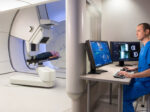World Head and Neck Cancer Day, observed every year on July 27, is a global initiative aimed at raising awareness of head and neck cancers, including cancers of the mouth, throat, nose, larynx, sinuses, skin, and salivary glands.
The campaign promotes the importance of cancer prevention, early detection, and patient access to advanced treatments.
Why does it matter?
Early diagnosis saves lives. Despite modern technology, many cases of head and neck cancer are still diagnosed at a late stage, when treatment is more complex and outcomes are poorer. World Head and Neck Cancer Day is a call to action not just for the public, but for clinicians, researchers, and healthcare providers worldwide.
At Proton International London, we’re proud to stand with the global cancer care community in highlighting both the progress and challenges in the diagnosis and treatment of head and neck cancers.
Fortunately, this year has seen a major milestone in the treatment of head and neck cancers.
Groundbreaking clinical evidence: Confirming the benefits of Proton Beam Therapy
This year’s most significant advance in the treatment of head and neck cancers comes from a Phase III multi-centre randomised trial, led by Dr Steven Frank of MD Anderson Cancer Center. The results were presented at ASCO 2024 and PTCOG 2025, and the abstract was published in the Journal of Clinical Oncology (JCO 2024).
The trial compared Intensity-Modulated Proton Therapy (IMPT) with the more common IMRT, x-ray-based radiation, in patients with oropharyngeal cancer. Oropharyngeal cancer is, unfortunately, continuing to become more common around the developed world, caused primarily by a virus rather than smoking or heavy alcohol use.
The findings confirmed what many in the proton therapy community have long observed in clinic:
- Cancer cure rates (i.e. progression-free survival (PFS)) were comparable with proton therapy.
- Overall survival was dramatically improved by 10% at 5 years with proton therapy.
- Proton beam therapy patients experienced a 33% relative reduction in feeding tube dependence, improving nutrition and quality of life.
- There were fewer severe treatment-related toxicities, including lymphopenia, thrombocytopenia, and neutropenia.
- Many proton patients were able to continue working during treatment, highlighting not just medical, but economic and social benefits. Proton patients were also more likely to return to work and more likely to stay at work at 3 and 5 years after treatment (Smith et al., IJPT 2021).
- Patients experienced fewer swallowing problems from treatment with protons, leading to improved weight maintenance and reduced malnutrition during treatment.
Dr Frank’s team, which includes Proton International’s Chief Medical Officer, Dr James W. Snider, continues to assess the long-term impact and economic value of proton beam therapy, both for patients and healthcare systems. However, the early data clearly demonstrate the cost-effectiveness of proton therapy and support a shift towards this modality as the preferred standard of care for many head and neck cancers.
Driving global quality in treatment planning
While the clinical benefits of proton beam therapy are clear, a recent study led by Dr Snider, Chief Medical Officer at Proton International, revealed that planning quality varies significantly across centres, even among global leaders.
At the PTCOG63 conference in Buenos Aires in June 2025, Dr. Snider presented a multi-institutional comparative planning study, in which 12 expert centres across Europe and the USA independently planned treatment for five standardised head and neck cancer cases.
- All centres delivered optimal tumour dosing.
- But there were marked differences in radiation exposure to surrounding organs at risk.
This variation underscores the need for standardised, high-quality treatment planning, especially as proton therapy expands globally.
To address this, Dr. Snider is forming an international task force to develop consensus guidelines and practical tools for head and neck PBT planning.
“We’re entering a new era for head and neck cancer care,” said Dr. Snider. “The evidence is clear that proton therapy improves outcomes. Now, we must ensure every patient benefits from consistently excellent treatment, no matter where they’re treated.”
Leading with expertise and education
Proton International London, in partnership with UCLH, is proud to provide evidence-based, consultant-led proton therapy in partnership with University College London Hospitals NHS Foundation Trust (UCLH). As the UK’s only private proton therapy centre, we are committed not only to delivering advanced treatment, but to supporting education, research, and global collaboration.
Our clinicians, physicists, dosimetrists, and radiographers are encouraged to engage with the latest data, participate in global planning studies, and help in setting the future standards for proton therapy.
On World Head and Neck Cancer Day, we reaffirm our commitment to progress.
From life-saving research to globally harmonised planning standards, Proton International London is proud to be helping shape a future where every patient has access to precise, protective, and powerful cancer treatment.





